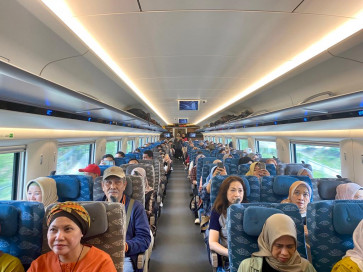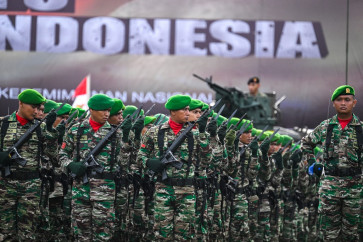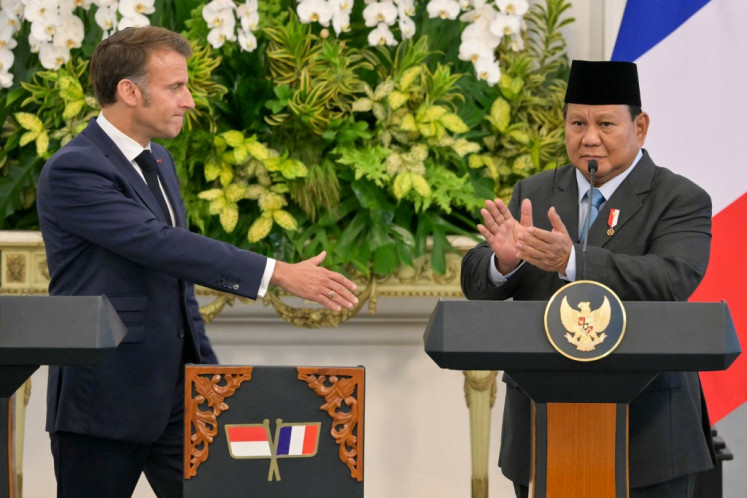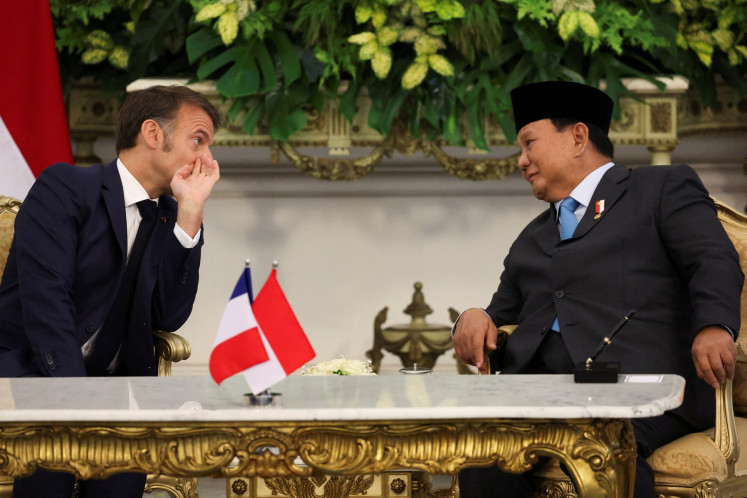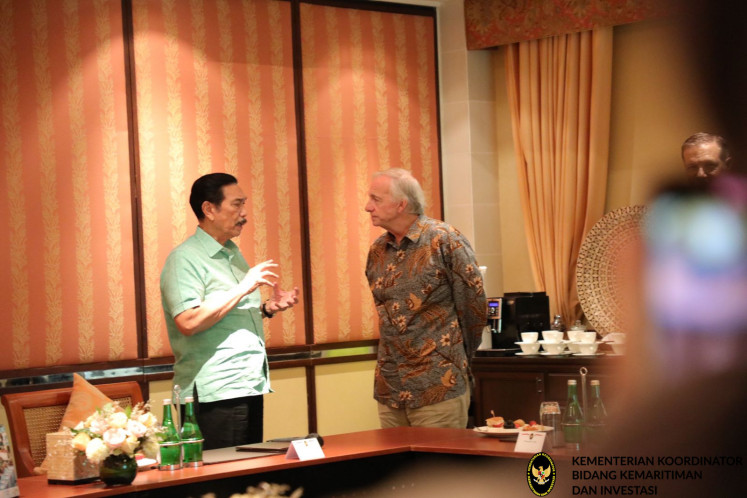Spice trail: uncover the paths of Indonesian history
Prized spice: Freshly harvested fuli pala (nutmeg mace) in Banda, Maluku, once the setting for a colonial power struggle with global implications
Change text size
Gift Premium Articles
to Anyone
 Prized spice: Freshly harvested fuli pala (nutmeg mace) in Banda, Maluku, once the setting for a colonial power struggle with global implications.(Courtesy of Museum Week/Danny Tumbelaka)" border="0" height="352" width="512">Prized spice: Freshly harvested fuli pala (nutmeg mace) in Banda, Maluku, once the setting for a colonial power struggle with global implications.(Courtesy of Museum Week/Danny Tumbelaka)
Prized spice: Freshly harvested fuli pala (nutmeg mace) in Banda, Maluku, once the setting for a colonial power struggle with global implications.(Courtesy of Museum Week/Danny Tumbelaka)" border="0" height="352" width="512">Prized spice: Freshly harvested fuli pala (nutmeg mace) in Banda, Maluku, once the setting for a colonial power struggle with global implications.(Courtesy of Museum Week/Danny Tumbelaka)A long forgotten story that put the ancient kingdoms of Indonesia on the world map is now being retold.
For centuries Indonesia was the main supplier of spices to the rest of the world, the main commodities being traded along the land route connecting Southeast Asia and Europe â the route that became known as the Silk Road.
There were at least 88 varieties of spices traded, many of them endemic plants, which were known and are still used today either for food ingredients, condiments, beauty products or medicinal purposes.
The high value of the spices brought power and wealth to the supplier kingdoms and lured European merchants and their mercenaries to Indonesian shores back in the 16th century.
Their arrival started the colonization of the archipelago by the Portuguese and Dutch for over 350 years.
âBy looking at the history of the spice trade and the reasons why the initially powerful kingdoms perished around that time this nation may be re-inspired and find the motivation to reclaim the world spice market,â historian JJ Rizal said at a media workshop on the Spice Trail on Monday.
Agriculture expert Didiek Setiabudi Hargono from Yayasan Kebun Raya Indonesia said that despite the stable demand in the world market, Indonesiaâs export volume of the spices had steadily declined until it matched its import volume.
âThe supply is low because farmers find they earn little from their hard work while there is still a government policy protecting local farmers and indigenous produce,â he said.
In that concern, The Jakarta Post-affiliated Yayasan Museum Indonesia will hold an exhibition at the National Museum in Central Jakarta from Oct. 18 to 25 for its annual Museum Week event, which is being staged for the third time.
The foundation content director Hani Fibianti said the exhibition would put on display pictures and related documents on the ancient kingdoms and the Spice Trail from across the archipelago.
âThe exhibition aims to remind us about the importance of spice trading to the culture and civilization of Indonesia. We have gathered information that shows the pepper trade in the 12th century elevated the Banten Sultanate into one of the worldâs great metropolises,â she said.
 Post-harvest: Nutmeg dries in Run Island, Banda, Maluku.(Courtesy of Museum Week/Danny Tumbelaka)
Post-harvest: Nutmeg dries in Run Island, Banda, Maluku.(Courtesy of Museum Week/Danny Tumbelaka)
Medical anthropologist Rusmin Tumanggor said that the use of camphor, the spice endemic to the Barus region in North Sumatra hence its local name kapur Barus, was age-old.
âThere are records of mantras in Sanskrit, Hebrew and Chinese that mention the use of camphor to cure diseases. It proves Barus was an important trading hub in the early human civilization age.â
Besides Bantenâs lada (pepper) and Barusâ camphor, Didiek said there were five other spices highly valued in the market today and which needed the governmentâs attention for sustainable farming and industry.
They are kayumanis (cinnamon), panili (vanilla), cengkeh (clove), which is native to the Maluku region, as well as pala (nutmeg) and kemiri (candlenut).
âCandlenut oil can make better biodiesel for fuel,â said Didiek.
Rusmin urged the government to start making an inventory of local spices and provide farmers with access to the market.
âWithout a fair strategy in cultivating spices, this country will face a difficult time in the future.â
Rizal said that the Spice Trail campaign would take place over five years targeting media and the school curriculum to deconstruct history.
âThere have been efforts to replace the Silk Road term with the Spice Trail for nostalgiaâs sake but what weâre trying to do here is to shed light on the pride of Indonesia.â
span class="caption">Prized spice: Freshly harvested fuli pala (nutmeg mace) in Banda, Maluku, once the setting for a colonial power struggle with global implications.(Courtesy of Museum Week/Danny Tumbelaka) A long forgotten story that put the ancient kingdoms of Indonesia on the world map is now being retold. For centuries Indonesia was the main supplier of spices to the rest of the world, the main commodities being traded along the land route connecting Southeast Asia and Europe ' the route that became known as the Silk Road. Medical anthropologist Rusmin Tumanggor said that the use of camphor, the spice endemic to the Barus region in North Sumatra hence its local name kapur Barus, was age-old.
P
There were at least 88 varieties of spices traded, many of them endemic plants, which were known and are still used today either for food ingredients, condiments, beauty products or medicinal purposes.
The high value of the spices brought power and wealth to the supplier kingdoms and lured European merchants and their mercenaries to Indonesian shores back in the 16th century.
Their arrival started the colonization of the archipelago by the Portuguese and Dutch for over 350 years.
'By looking at the history of the spice trade and the reasons why the initially powerful kingdoms perished around that time this nation may be re-inspired and find the motivation to reclaim the world spice market,' historian JJ Rizal said at a media workshop on the Spice Trail on Monday.
Agriculture expert Didiek Setiabudi Hargono from Yayasan Kebun Raya Indonesia said that despite the stable demand in the world market, Indonesia's export volume of the spices had steadily declined until it matched its import volume.
'The supply is low because farmers find they earn little from their hard work while there is still a government policy protecting local farmers and indigenous produce,' he said.
In that concern, The Jakarta Post-affiliated Yayasan Museum Indonesia will hold an exhibition at the National Museum in Central Jakarta from Oct. 18 to 25 for its annual Museum Week event, which is being staged for the third time.
The foundation content director Hani Fibianti said the exhibition would put on display pictures and related documents on the ancient kingdoms and the Spice Trail from across the archipelago.
'The exhibition aims to remind us about the importance of spice trading to the culture and civilization of Indonesia. We have gathered information that shows the pepper trade in the 12th century elevated the Banten Sultanate into one of the world's great metropolises,' she said.
'There are records of mantras in Sanskrit, Hebrew and Chinese that mention the use of camphor to cure diseases. It proves Barus was an important trading hub in the early human civilization age.'
Besides Banten's lada (pepper) and Barus' camphor, Didiek said there were five other spices highly valued in the market today and which needed the government's attention for sustainable farming and industry.
They are kayumanis (cinnamon), panili (vanilla), cengkeh (clove), which is native to the Maluku region, as well as pala (nutmeg) and kemiri (candlenut).
'Candlenut oil can make better biodiesel for fuel,' said Didiek.
Rusmin urged the government to start making an inventory of local spices and provide farmers with access to the market.
'Without a fair strategy in cultivating spices, this country will face a difficult time in the future.'
Rizal said that the Spice Trail campaign would take place over five years targeting media and the school curriculum to deconstruct history.
'There have been efforts to replace the Silk Road term with the Spice Trail for nostalgia's sake but what we're trying to do here is to shed light on the pride of Indonesia.'
Your Opinion Matters
Share your experiences, suggestions, and any issues you've encountered on The Jakarta Post. We're here to listen.
Thank You
Thank you for sharing your thoughts. We appreciate your feedback.
Share options
Quickly share this news with your network—keep everyone informed with just a single click!
Gift Premium Articles
to Anyone
Share the best of The Jakarta Post with friends, family, or colleagues. As a subscriber, you can gift 3 to 5 articles each month that anyone can read—no subscription needed!
Continue in the app
Get the best experience—faster access, exclusive features, and a seamless way to stay updated.

